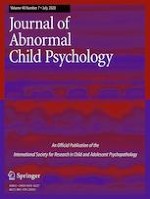13-12-2019
Application of the Bifactor S – 1 Model to Multisource Ratings of ADHD/ODD Symptoms: an Appropriate Bifactor Model for Symptom Ratings
Gepubliceerd in: Research on Child and Adolescent Psychopathology | Uitgave 7/2020
Log in om toegang te krijgenAbstract
The symmetrical bifactor model is often applied to attention-deficit/hyperactivity disorder (ADHD)-hyperactive/impulsive (HI), ADHD-inattentive (IN), and oppositional defiant disorder (ODD) symptoms, but this model frequently yields anomalous or inadmissible results. An alternative model, the bifactor S – 1 model, is more appropriate for examining the hierarchical structure of ADHD/ODD symptoms. Both models were applied to ADHD-HI, ADHD-IN, and ODD symptom ratings by mothers, fathers, and teachers for 2142 Spanish children (49.49% girls; ages 8–13 years). The symmetrical bifactor model yielded the typical anomalous loadings, with a weakly defined ADHD-HI specific factor and difficult to interpret associations of general and specific factors with correlates. In contrast, the bifactor S – 1 model with ADHD-HI symptoms as general reference factor produced clearly interpretable results. For mothers and fathers, slightly more than 50% of true score variance in ADHD-IN and ODD symptoms represented specific residual variance not shared with the general ADHD-HI reference factor. For teachers, approximately 69% and 39% of true score variance in ADHD-IN and ODD symptoms, respectively, represented specific residual variance not shared with the general ADHD-HI reference factor. The general ADHD-HI reference factor and specific ADHD-IN and ODD residual factors showed convergent and discriminant validity across sources, along with unique associations with peer rejection, social impairment, and academic impairment factors. The bifactor S – 1 model also yielded results consistent with predictions from trait-impulsivity theory of ADHD/ODD development. Researchers should use the bifactor S – 1 model rather than the symmetrical bifactor model if hypotheses involve the latent hierarchical structure of ADHD/ODD symptoms.
